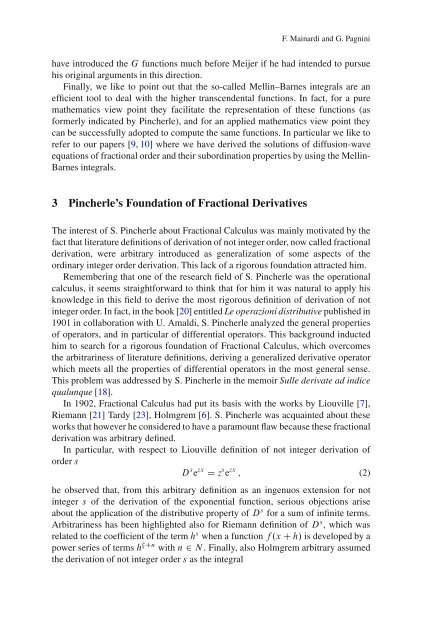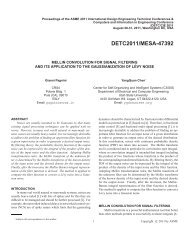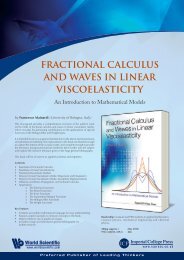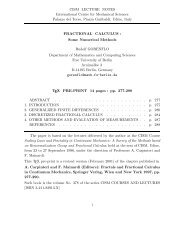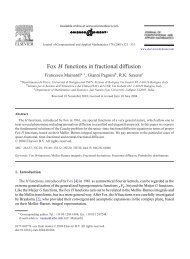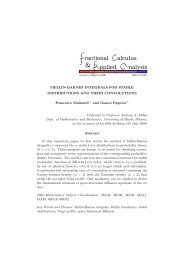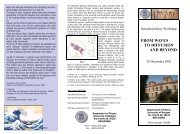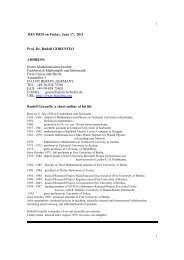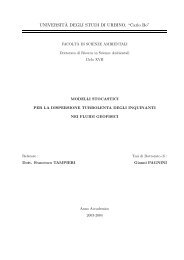The Role of Salvatore Pincherle in the Development of Fractional ...
The Role of Salvatore Pincherle in the Development of Fractional ...
The Role of Salvatore Pincherle in the Development of Fractional ...
You also want an ePaper? Increase the reach of your titles
YUMPU automatically turns print PDFs into web optimized ePapers that Google loves.
F. Ma<strong>in</strong>ardi and G. Pagn<strong>in</strong>i<br />
have <strong>in</strong>troduced <strong>the</strong> G functions much before Meijer if he had <strong>in</strong>tended to pursue<br />
his orig<strong>in</strong>al arguments <strong>in</strong> this direction.<br />
F<strong>in</strong>ally, we like to po<strong>in</strong>t out that <strong>the</strong> so-called Mell<strong>in</strong>–Barnes <strong>in</strong>tegrals are an<br />
efficient tool to deal with <strong>the</strong> higher transcendental functions. In fact, for a pure<br />
ma<strong>the</strong>matics view po<strong>in</strong>t <strong>the</strong>y facilitate <strong>the</strong> representation <strong>of</strong> <strong>the</strong>se functions (as<br />
formerly <strong>in</strong>dicated by <strong>P<strong>in</strong>cherle</strong>), and for an applied ma<strong>the</strong>matics view po<strong>in</strong>t <strong>the</strong>y<br />
can be successfully adopted to compute <strong>the</strong> same functions. In particular we like to<br />
refer to our papers [9, 10] where we have derived <strong>the</strong> solutions <strong>of</strong> diffusion-wave<br />
equations <strong>of</strong> fractional order and <strong>the</strong>ir subord<strong>in</strong>ation properties by us<strong>in</strong>g <strong>the</strong> Mell<strong>in</strong>-<br />
Barnes <strong>in</strong>tegrals.<br />
3 <strong>P<strong>in</strong>cherle</strong>’s Foundation <strong>of</strong> <strong>Fractional</strong> Derivatives<br />
<strong>The</strong> <strong>in</strong>terest <strong>of</strong> S. <strong>P<strong>in</strong>cherle</strong> about <strong>Fractional</strong> Calculus was ma<strong>in</strong>ly motivated by <strong>the</strong><br />
fact that literature def<strong>in</strong>itions <strong>of</strong> derivation <strong>of</strong> not <strong>in</strong>teger order, now called fractional<br />
derivation, were arbitrary <strong>in</strong>troduced as generalization <strong>of</strong> some aspects <strong>of</strong> <strong>the</strong><br />
ord<strong>in</strong>ary <strong>in</strong>teger order derivation. This lack <strong>of</strong> a rigorous foundation attracted him.<br />
Remember<strong>in</strong>g that one <strong>of</strong> <strong>the</strong> research field <strong>of</strong> S. <strong>P<strong>in</strong>cherle</strong> was <strong>the</strong> operational<br />
calculus, it seems straightforward to th<strong>in</strong>k that for him it was natural to apply his<br />
knowledge <strong>in</strong> this field to derive <strong>the</strong> most rigorous def<strong>in</strong>ition <strong>of</strong> derivation <strong>of</strong> not<br />
<strong>in</strong>teger order. In fact, <strong>in</strong> <strong>the</strong> book [20] entitled Le operazioni distributive published <strong>in</strong><br />
1901 <strong>in</strong> collaboration with U. Amaldi, S. <strong>P<strong>in</strong>cherle</strong> analyzed <strong>the</strong> general properties<br />
<strong>of</strong> operators, and <strong>in</strong> particular <strong>of</strong> differential operators. This background <strong>in</strong>ducted<br />
him to search for a rigorous foundation <strong>of</strong> <strong>Fractional</strong> Calculus, which overcomes<br />
<strong>the</strong> arbitrar<strong>in</strong>ess <strong>of</strong> literature def<strong>in</strong>itions, deriv<strong>in</strong>g a generalized derivative operator<br />
which meets all <strong>the</strong> properties <strong>of</strong> differential operators <strong>in</strong> <strong>the</strong> most general sense.<br />
This problem was addressed by S. <strong>P<strong>in</strong>cherle</strong> <strong>in</strong> <strong>the</strong> memoir Sulle derivate ad <strong>in</strong>dice<br />
qualunque [18].<br />
In 1902, <strong>Fractional</strong> Calculus had put its basis with <strong>the</strong> works by Liouville [7],<br />
Riemann [21] Tardy[23], Holmgrem [6]. S. <strong>P<strong>in</strong>cherle</strong> was acqua<strong>in</strong>ted about <strong>the</strong>se<br />
works that however he considered to have a paramount flaw because <strong>the</strong>se fractional<br />
derivation was arbitrary def<strong>in</strong>ed.<br />
In particular, with respect to Liouville def<strong>in</strong>ition <strong>of</strong> not <strong>in</strong>teger derivation <strong>of</strong><br />
order s<br />
D s e zx D z s e zx ; (2)<br />
he observed that, from this arbitrary def<strong>in</strong>ition as an <strong>in</strong>genuos extension for not<br />
<strong>in</strong>teger s <strong>of</strong> <strong>the</strong> derivation <strong>of</strong> <strong>the</strong> exponential function, serious objections arise<br />
about <strong>the</strong> application <strong>of</strong> <strong>the</strong> distributive property <strong>of</strong> D s for a sum <strong>of</strong> <strong>in</strong>f<strong>in</strong>ite terms.<br />
Arbitrar<strong>in</strong>ess has been highlighted also for Riemann def<strong>in</strong>ition <strong>of</strong> D s ,whichwas<br />
related to <strong>the</strong> coefficient <strong>of</strong> <strong>the</strong> term h s when a function f.xC h/ is developed by a<br />
power series <strong>of</strong> terms h Cn with n 2 N . F<strong>in</strong>ally, also Holmgrem arbitrary assumed<br />
<strong>the</strong> derivation <strong>of</strong> not <strong>in</strong>teger order s as <strong>the</strong> <strong>in</strong>tegral


